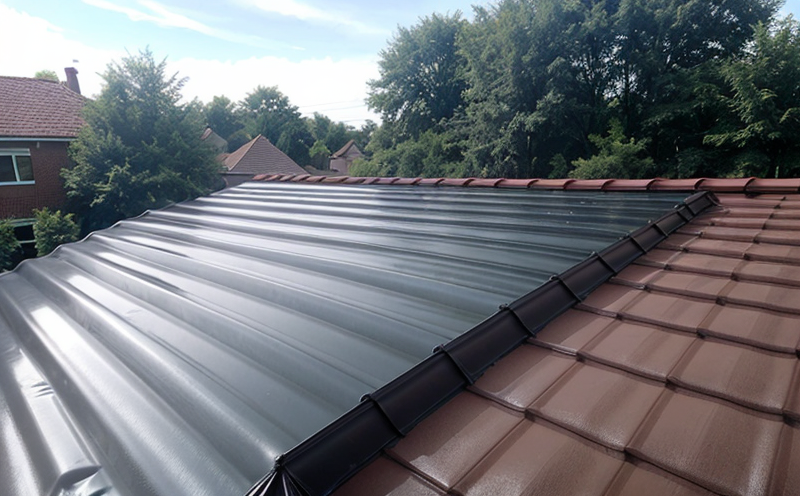ASTM D5149 Water Penetration Testing of Roof Membranes
The ASTM D5149 water penetration test is a critical procedure used to evaluate the waterproofing capabilities of roof membranes. This test simulates the effects of rain and other forms of precipitation on a roof membrane, ensuring that it can withstand environmental conditions without allowing water intrusion. The test is particularly important for quality managers, compliance officers, R&D engineers, and procurement professionals involved in building & infrastructure projects.
The ASTM D5149 procedure involves subjecting the sample to water at specific pressures and durations while monitoring the rate of water penetration. The specimen is typically a 30.5 cm by 61 cm (12 inches by 24 inches) piece of roof membrane, which is secured in a specially designed apparatus. During the test, water is sprayed from nozzles positioned to simulate real-world rain conditions.
The apparatus used for ASTM D5149 testing includes:
- Water spray nozzles
- A pressure-regulating pump
- A leak-detection device (e.g., a manometer)
- An observation chamber for the specimen
The test is conducted under controlled conditions, and it must follow specific parameters to ensure accurate results. The specimen is exposed to water at pressures ranging from 5 psi to 20 psi (34 kPa to 138 kPa) for durations that can vary depending on the membrane type and expected service life.
| Parameter | Description |
|---|---|
| Water Pressure | Ranges from 5 psi to 20 psi (34 kPa to 138 kPa), depending on the membrane type. |
| Durational Exposure Time | Can vary but is typically at least 6 hours for standard tests. |
| Water Source | Pure water, free from contaminants that might affect the test results. |
The acceptance criteria for ASTM D5149 are straightforward: no leakage should occur under the specified conditions. If there is any visible or measurable water penetration through the membrane during the test, it indicates a failure of the waterproofing layer.
Understanding the ASTM D5149 procedure and its importance in ensuring roof integrity can help building professionals make informed decisions about material selection and installation techniques. This test is crucial for maintaining compliance with local codes and standards while enhancing the durability and longevity of roofing systems.
Why It Matters
The ASTM D5149 water penetration test is essential because it ensures that roof membranes can effectively prevent water intrusion, which is critical for the structural integrity and safety of buildings. Water penetration in roofs can lead to mold growth, corrosion, and other issues that compromise building performance and occupant comfort.
By conducting this test, builders and contractors can verify that the materials they choose meet the necessary standards and perform as expected under real-world conditions. This helps in maintaining compliance with local regulations and industry best practices, thereby protecting investments and ensuring long-term reliability of roofing systems.
Why Choose This Test
The ASTM D5149 test is a preferred choice for several reasons. Firstly, it provides a standardized method to evaluate the waterproofing performance of roof membranes, ensuring consistency and comparability across different products and manufacturers.
Secondly, this test helps identify potential weaknesses in roof membranes early in the design or manufacturing process, allowing for corrective actions before product release. It also aids in quality control during production runs by offering a reliable metric to assess membrane performance.
Thirdly, compliance with ASTM D5149 is often required by building codes and insurance underwriting guidelines, making it an indispensable tool for professionals working in the building & infrastructure sector. By choosing this test, stakeholders ensure that their roofing solutions meet these stringent requirements and deliver superior performance over extended periods.
Use Cases and Application Examples
- New Roof Membrane Development: ASTM D5149 testing is crucial during the development phase to identify optimal waterproofing solutions for various climates and environmental conditions.
- R&D Projects: Researchers use this test to innovate and improve existing roofing materials, focusing on enhanced durability and water resistance.
- Material Suppliers: Manufacturers rely on ASTM D5149 testing to ensure that their products meet the highest standards of waterproofing performance before market release.
In real-world applications, this test is used to evaluate materials like modified bitumen membranes (MBMs), single-ply membranes (SPMs), and polymer-modified bituminous materials. These materials are subjected to ASTM D5149 testing to ensure they can withstand harsh weather conditions without compromising the integrity of the roof.





